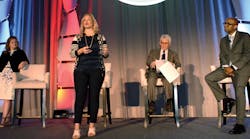TTMA panelists discuss key factors in hiring, retaining employees in a digital age
The Truck Trailer Manufacturers Association hosted a human resources panel called “Hiring, Training, Retaining—The Shop Floor to the Board Room” during its annual convention in Bonita Springs, Florida.
The panel, moderated by Darrell Finney, president of Fin Tek Consulting, featured Kristin Glazner, senior vice president and chief HR officer for Wabash National, Dr Robert Lerman, a researcher at Urban Institute, and Emily Schmitt, general council at Sukup Manufacturing, and focused on 10 key HR topics: company culture, health care, wages, career paths, mental health, recruitment and onboarding, internships and apprenticeships, marijuana and work, workweek, and adaptability.
“Your ability as an organization to attract, retain and recruit talent at all levels is critical to your success, not only in achieving your business objectives but in continuing to hopefully exceed your customers’ expectations,” Finney said.
In addition, Lerman talked about the need for more apprenticeships in manufacturing, and Schmitt spotlighted her company’s Safe T Homes initiative, which transforms grain bins into sturdy, much-needed housing for the homeless—and also reinforces its image as a family-focused business.
“If you want to improve HR, you’ve got to have a mission, you’ve got to have the tools—like apprenticeships—and you really have to be intentional about putting it out there, to make sure your employees know you really do mean it,” Schmitt said.
Apprenticeships
Lerman advocated for more apprenticeships, which typically last longer than internships and come with pay, to educate and prepare the next generation of workers for careers in manufacturing.
He said apprenticeships, which can help employers identify well-qualified, team-oriented candidates with the right skillsets, are vitally important, but often companies are fuzzy on what they entail. Key elements include:
- Structured work-based learning under a qualified mentor/trainer
- Contributions to production, with wages
- Related theoretical instruction (classes)
- Work-based and classroom instruction guided by well-defined occupational frameworks
“It’s an effective form of learning because it’s learning in context, learning by doing,” Lerman said. “The theory is fine, but you want to apply it, and encounter the various issues that arise from time to time.
“And completion leads to an occupational credential.”
Lerman said most firms are able to recoup their investments during the apprenticeship, while also reducing turnover and recruitment costs, and raising innovation through employer-led training.
He said reasons to spend on training, even when newly trained employees can be poached by other companies, include:
- Learning about trainees as they’re trained, giving prospective employers a clearer picture of the trainee’s character
- General skills often compliment specific skills
- Offering extensive training attracts applicants who want to learn, an infectious attitude that can rub off on more established employees
- Some occupational skills are only learned in the workplace
To discover more information about how to establish a successful apprenticeship program, and the myriad
occupational frameworks and competency-based measures that Urban Institute makes available, please visit urban.org/policy-centers/center-labor-human-
services-and-population/projects/competency-based-
occupational-frameworks-registered-apprenticeships.
Safe T Home
The Safe T Home program is one of the initiatives Sukup uses to put words into action, and maintain the small-company feel they enjoyed 56 years ago when Schmitt’s grandfather founded the business. Sukup still had only 200 employees only 20 years ago but now employs more than 600.
Sukup started the program in 2010 after an earthquake hit Haiti, leaving many people without a home. Safe T Homes are 18 feet in diameter and constructed entirely of metal, making them resistant to termites and moisture—and virtually earthquake proof. The homes, easily erected on-site, also are built to withstand hurricane-force winds and last up to 75 years. Each home sleeps 10 or more and features a double-roofed system that displaces heat and a full-size, lockable steel door.
Schmitt also spoke about Sukup’s on-site clinic for employees, Sukup Health Solutions, which opened in April, 2018, and its biannual in-person employee “conversations” with a company family member, both of which help establish Sukup Manufacturing as a place where people want to work.
“You don’t have to be family owned to find initiatives that make your company feel family focused,” Schmitt said.
Visit sukup.com for more information.
Culture
TTMA: “Nine out of 10 Millennials would take a pay cut at a company that aligns with their values, rather than a higher wage at a company that doesn’t align.”
When it comes to a company’s acceptable norms, attitudes and behaviors, it is important to have a plan in place that ensures employees, and their leaders, are living up to a company’s stated values, Glazner said. The key is to make the plan specific to a company’s employees, and show how they connect.
Glazner said Brent Yeagy, Wabash’s CEO, insisted they are “going to choose to put people first,” establishing the company’s deliberate mission that informs every HR decision, including how Wabash supports its employees, and how it provides educational and career development, and meaningful feedback.
“If you just tell people, ‘We’re putting people first,’ they’re going to expect something,” Glazner said. “If you say ‘choose,’ you’re making a plan. We are going to plan putting people first.”
Schmitt emphasized the importance of being intentional about an HR plan. Sukup’s Safe T Home program resonates with people in the Midwest—Sukup’s manufacturing facility is in Sheffield IA—who see grain bins daily all around them, and then see the same structures saving lives.
Also, more mission transparency within a company helps differentiate it from competitors, and reassure millennials.
“There are so many avenues to tell your story, and resonate with people, so you should really take advantage of that,” Schmitt said. “Social media is an example of that. We have customers who, even though we’re not the cheapest, per product, buy from us because they heard about the Safe T Home record.”
Health care
TTMA: “(In an) interconnected society, (it’s) important to connect employees with their health resources like they are connected with their banking, credit cards, and the like.”
Schmitt said Sukup, like many companies, found that its employees don’t like going to the doctor and don’t make regular checkups, often leading to worse health problems down the road. So it opened an on-site clinic with a registered nurse five days a week, and a nurse practitioner once a week. “It really reduced the hurdle of people going to see a doctor,” Schmitt said.
Glazner said Wabash, as of April 1, has a director of wellness, along with a wellness task force, wellness credits and a wellness app. The wellness director helps people understand their benefits, and how to integrate them into their daily lives, the wellness task force helps ensure the company is making wellness actionable for its employees around the world, and credits incentivize preventative measures.
Wages
TTMA: “When are there discussions to keep up with wages with competitive market, low unemployment, and high availability for comparisons?”
Wages are an intensely personal topic, and company approaches vary widely, but Wabash tries to revisit the top regularly and is willing to adjust, Glazner said. Believing its already competitive in the area, the trailer manufacturer looks at other factors, including benefits, work flexibility and quality of life, as exemplified by its decision to provide free transportation to work for employees in Lafayette LA.
Schmitt said Sukup still is trying to improve its wage structures, while recognizing new issues in a digital era, like transparency and perception. Cost of living plays a key role in wage setting, but online people only see their salary is far less than, say, someone living in Los Angeles, or the national average. The company also has provided no-cost health-care premiums since the 1970s, but younger generations don’t seem to see the same value in the offering, instead preferring more up-front pay.
“You have to be ahead of the curve, so you have to look at where are the averages at, and whether you think it’s too high or not, that’s what they’re seeing,” Schmitt said.
Career paths
TTMA: “Millennials thirst for continuous learning opportunities.”
Glazner said there are three key elements in defining career paths. First, people need to understand what is the next step, whether it’s traditional, flexible, tailored or otherwise. Second, they need real-time communication that’s constant, and third, they need to have diagonal options that inspire creativity.
Lerman said apprenticeships, which he calls “pathways to rewarding careers,” are a vehicle for enhancing career paths. Apprenticeships help people learn how to learn, enable lifetime learning, instill pride in those who complete them, and create empowered experts who make up a “community of practice.”
Mental health
TTMA: “What is your company doing regarding employee mental health?”
With so many outside forces affecting employees at the workplace, many stemming from the growth of the internet, Sukup addresses mental health at its on-site clinic, in part through online counseling, and tries to grow awareness of mental health issues through a willingness to talk about them, and “Wellness Wednesdays.”
Glazner said Wabash requires its HR team members to go to counseling, so they know what it’s all about when suggesting it to others.
Recruitment and onboarding
TTMA: “(With) newspaper audience decreasing, go to where the applicants are—online.”
Glazner, who referred to Wabash’s onboarding as “candidate care,” said it’s important for prospective employees to easily understand an organization’s culture. First impressions are key, so a company’s communications must be planned and purposeful, particularly in introducing itself online, where many younger candidates first learning about the company through social media like Facebook.
“Work-hardening,” or teaching employees the skills required to do the job, and how to meet company expectations, is critical, Glazner said, and Schmitt says Sukup always begins onboarding on Mondays, keeps it recruitment videos fresh, and treats trainees to lunch on their first day.













